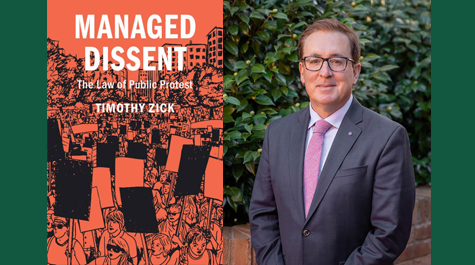Q&A with Professor Timothy Zick, author of “Managed Dissent: The Law of Public Protest”
Timothy Zick, John Marshall Professor of Government and Citizenship at William & Mary Law School, recently authored a new book examining the practice of public protest and the laws which govern street demonstrations. Inspired by and written in the wake of the protests across the country following the 2020 police murder of George Floyd, Professor Zick argues that reforms are necessary to preserve public protest for current and future generations.
Below, we ask Professor Zick a few questions about his book, published in May by Cambridge University Press, and how the past few years of high-profile public protests and gatherings have altered the law, and may influence the next wave of public dissent.
Q. Professor Zick, what led you toward writing about laws governing public protest in the United States?
A. My first book, “Speech Out of Doors,” was about the significance of public place to First Amendment rights. So I’ve long been interested in how people use public places to communicate, and how governments manage and control these places. The specific impetus for “Managed Dissent” was the mass protests that followed George Floyd’s murder. The demonstrations, which were likely the largest in U.S. history, highlighted both the potential of public dissent and the pathologies of its regulation.
Q. As you wrote the book, what stood out most to you? What was particularly noteworthy, troubling or impactful?
A. On the positive side, millions of Americans participated in mass demonstrations. It has been said that in a digital era, this kind of direct political action is obsolete. The death of public protest has been greatly exaggerated. The most troubling aspect of the 2020 demonstrations was the frequency of aggressive policing and violent law enforcement tactics. Protest policing has long been a central pathology of the law of public protest. During the racial justice protests, law enforcement fired tear gas into peaceful crowds, used physical force against compliant protesters, and abused unlawful assembly and other public order laws.
Q. Public protest and demonstration have been a central part of American history since its earliest days. How have laws governing it changed throughout our nation's history?
A. On the surface, the American law of public protest preserves important opportunities for peaceable assembly and speech. However, over time the combination of constitutional doctrine, legal bureaucracy, and law enforcement practices has significantly narrowed such opportunities. The law of public protest has managed public dissent in ways that have made it more dangerous, more costly and less effective.
Q. The U.S. has experienced several high-profile protests and gatherings in recent years, perhaps most notably in 2020 in the wake of the murder of George Floyd, but also the Capitol Insurrection on Jan. 6, 2021. How have these events shaped recent legislative efforts and altered public demonstrations for the future?
A. Public demonstrations have always created legislative backlash. In response to public demonstrations, many states enacted new public order laws, increased fines for civil disobedience, and adopted other penalties relating to public protest activity. These laws may chill future public demonstrations. The January 6 insurrection, the epitome of an unlawful riot, resulted in many criminal convictions – including on rare “sedition” charges for members of the Proud Boys and Oath Keepers. Those convictions will hopefully deter future seditionists and insurrectionists from engaging in violent protests.
♦♦♦
If you’d like to read more, Professor Zick’s writing and expertise have been featured in Slate, The Atlantic, The Conversation, and CNN.com.
About William & Mary Law School
Thomas Jefferson founded William & Mary Law School in 1779 to train leaders for the new nation. Now in its third century, America's first law school continues its historic mission of educating citizen lawyers who are prepared both to lead and to serve.